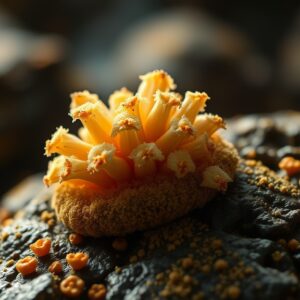Amensalism is a fascinating ecological interaction characterized by a one-sided relationship where one organism is harmed while the other remains unaffected. This phenomenon plays a significant role in shaping community dynamics, influencing biodiversity, and affecting ecosystem health. Understanding specific examples of amensalism can provide valuable insights into how these interactions occur in nature and their implications for ecological balance. This article explores various examples of amensalism across different ecosystems, highlighting the mechanisms involved and their ecological significance.
1. Allelopathy in Plants
One of the most well-known examples of amensalism occurs in the plant kingdom through a process called allelopathy. In this interaction, one plant species releases chemicals that inhibit the growth or survival of neighboring plant species.
- Black Walnut (Juglans nigra): The black walnut tree is a classic example of allelopathy. It produces a compound called juglone, which is toxic to many other plants, including tomatoes, potatoes, and certain ornamental species. The presence of black walnut trees creates a zone of inhibition around them, limiting the growth of competing vegetation. This allows the walnut tree to thrive in its environment while negatively impacting the growth of nearby plants.
- Sorghum (Sorghum bicolor): Sorghum is another plant that exhibits allelopathic properties. It releases allelochemicals that can suppress the growth of weeds and other crops. Farmers often utilize sorghum in crop rotation systems to manage weed populations effectively, demonstrating how allelopathy can be harnessed for agricultural benefits.
2. Competition Among Species
Competition is a significant mechanism of amensalism, where one species outcompetes another for limited resources, leading to the decline or local extinction of the less competitive species.
- Invasive Species: Invasive species often exhibit competitive amensalism by outcompeting native species for resources. For example, the introduction of the zebra mussel (Dreissena polymorpha) in North America has led to the decline of native mussel populations. Zebra mussels filter large amounts of water, consuming phytoplankton and depriving native mussels of food, ultimately harming their populations without benefiting the zebra mussels.
- Plant Competition: In dense plant communities, taller species may overshadow shorter ones, limiting their access to sunlight. For instance, in a forest ecosystem, large trees can block sunlight from reaching understory plants, inhibiting their growth and reproduction. This competitive exclusion can lead to reduced diversity in the plant community.
3. Physical Damage from Grazing
Physical damage is a mechanism of amensalism that occurs when one organism causes harm to another through direct physical interactions, such as trampling or grazing.
- Grazing Animals: Large herbivores, such as cattle or deer, can trample and damage vegetation while foraging. For example, when cattle graze in a pasture, they may trample young plants and seedlings, leading to their destruction. While the cattle benefit from the available forage, the plants suffer from physical damage, which can hinder their growth and reproduction.
- Human Activities: Urbanization and land development can also cause physical damage to ecosystems. Construction activities can destroy habitats and lead to the decline of local flora and fauna. For instance, the expansion of urban areas often results in the loss of natural habitats, negatively impacting the species that depend on those environments.
4. Pathogen Release
Pathogen release is a mechanism of amensalism where one organism negatively impacts another by acting as a vector for diseases or pathogens.
- Insects as Vectors: Certain insects can carry pathogens that harm plants or other organisms. For example, aphids can transmit viral diseases to crops, leading to reduced yields and plant health. The aphids themselves are not affected by the viruses they carry, demonstrating a clear case of amensalism.
- Fungal Pathogens: Some plants may harbor fungal pathogens that can spread to neighboring plants, causing disease and decline. For instance, the spread of the fungal pathogen Phytophthora ramorum has led to significant mortality in oak and tanoak trees in California. The infected trees can act as a source of infection for healthy trees, resulting in widespread damage without any benefit to the infected trees.
5. Chemical Inhibition in Microbial Communities
Chemical inhibition is a broader category that encompasses various ways in which one organism can negatively affect another through the release of toxic substances or metabolic byproducts.
- Bacterial Interactions: Certain bacteria can produce inhibitory compounds that affect the growth of competing bacterial species. For instance, some soil bacteria release antibiotics that suppress the growth of pathogenic bacteria. In this case, the beneficial bacteria harm their competitors without gaining any advantage, illustrating a form of amensalism.
- Aquatic Environments: In aquatic ecosystems, phytoplankton can release toxins that inhibit the growth of competing algal species. For example, harmful algal blooms (HABs) can produce toxins that not only affect aquatic life but also inhibit the growth of other algal species, leading to shifts in community composition and nutrient dynamics in the water column.
Conclusion
Amensalism is a complex and important ecological interaction that can significantly influence community dynamics and biodiversity. Through various mechanisms such as allelopathy, competition, physical damage, pathogen release, and chemical inhibition, amensalism shapes the relationships between organisms in diverse ecosystems. Understanding specific examples of amensalism enhances our knowledge of ecological interactions and their implications for biodiversity conservation and ecosystem management. By recognizing the intricacies of amensalism, we can better appreciate the delicate balance that exists within nature and the importance of protecting it for future generations.
